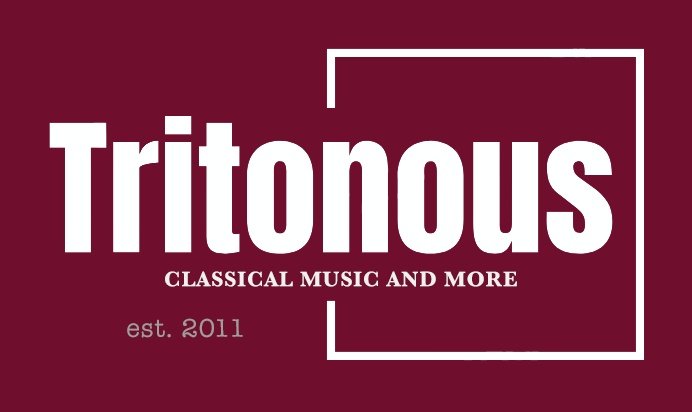I started with the String Quartet, which interested me the most. It is the only work on this CD not denoted as a world premiere recording, but after an exhaustive search, I can’t find any previous recordings of it. There are several live performances of it on YouTube (with variable quality), and even an interesting transcription of it for string orchestra, but no commercial CD release that I can find. So I’m curious about that. In any event, this new Naxos CD becomes even more invaluable, as this work is quite remarkable.
My first impression when listening to it, however, was the rather strange recorded sound. The quartet sounds like they’re set back within an empty, bathtubby acoustic (which actually sounds rather like a high school gymnasium), but closely mic’d by the engineers to bring them forward in an effort to mitigate the cavernous reverberation. Very strange indeed. It’s not terrible, but not up to the usual high standards we have come to expect from Naxos. I read in the booklet it was recorded in an old, palace castle in Ettersburg, Germany, and one wonders under what circumstances the decision was made to record it there, of all places. Fortunately the rest of the program was recorded elsewhere, and the sound improves commensurately.
But never mind, I soon forgot all about the acoustic as the music grabbed my attention and never let go. The Quartet is subtitled “Divorce” – and that proved interesting, because this music is often angry, as if the players are arguing back and forth with one another. And reading the composer’s brief note in the booklet confirms that is exactly what Say is trying to portray in this music. The piece represents his personal experience with divorce, separation and failure of a relationship – presumably corresponding to each of the 3 movements.
The opening Allegro maestoso establishes the mood immediately. It is sparsely scored, almost stark, and sounds irritated (if not quite angry yet), played with sharp, incisive, stabbing bowing and a deliberate coldness, with absolutely no vibrato. Oh yes, it’s cold. Icy even. (The movie The War of the Roses comes to mind. Ha!) The Andante is less agitated, but still quite chilly – sans vibrato – and lacking warmth, as if one is receiving (or giving) the cold shoulder treatment. Then, ingeniously, a bit of vibrancy sneaks into the violin solo – just barely a shimmer at first – above the icy atmosphere. Soon a 2nd violin joins with a touch more vibrato still, then the viola too, with even more pronounced vibrato yet – all over an incessant, menacing pizzicato cello accompaniment. And amazingly, just when it seems we’re becoming on friendlier terms, it instead begins to boil with angst – the vibrato tightens and increases into a frantic speed, growing into tremolos and sul-pont scratchings. (One wonders if this is notated in the score to be played this way, or has the Gropius Quartett envisioned and executed it this way?)
And the presto breaks out angrily with agitated, rhythmic propulsion and furious string flurries, as if the players are bickering amongst themselves. And amid the squabble, I couldn’t help but smile, amused at the vivid and realistic portrayal of what I imagine is happening in the storyline. The piece ends as it began, with a recapitulation of the main theme from the 1st movement. And I take pause here and consider (once again) what a great composer Fazil Say is, and what a great piece this is. And marvel at the fantastic playing of the Gropius Quartett.
Eager for more, I venture onward to his String Sextet, “Leopards”, where Say adds an additional viola and cello to the quartet. It is rather similar in style, with transparent, almost stark scoring and incisive articulated passages. The recording here sounds much more natural and atmospheric than in the Quartet, with a realism which increases the vivid characterization of nature.
This is a pretty amazing work. It’s even more rhythmic than the Quartet, and incorporates more innovative string techniques (such as snap-pizzicato and some screeching portamentos way up in the highest registers, for example), and even some percussive effects, such as banging knuckles on the wooden body of the cellos. This lends a bit of the feel of a safari – which Say states he personally experienced and was the inspiration for the work. But the effects are never excessive or hackneyed; Say is a consummate composer and it’s tastefully incorporated into the music – absolutely effective in depicting the wildness of nature, leopards in particular.
After all the driving rhythmic energy (and glissando sighing, again sul-pont) of the opening few minutes (which is, incidentally, marked Allegro assai energico, “extremely rhythmical”), there is an abrupt pause, followed by more atmospheric knocking on the cellos. Then a really eerie, otherworldly melody (sort of) emerges. What is that? – a violin playing legato col legno (with the wood side of the bow)? It sounds very much like what George Crumb specifies for that awesomely weird little violin tune in the “Sounds of Bones and Flutes” in Black Angels. But Eichhorn adds frantic vibrato to it, with ghostly effect. Soon, some not-so-subtle cat growls from sul-pont cellos and some frightened bird screeches way up high in the violins create an even creepier atmosphere. Even as a foreboding tune appears in the violas, there is a constant, nightmarish atmosphere going on everywhere around it – growls, shrieks, glissandos – and persistent pounding rhythms depicting a trek through the safari, surrounded by unknown wildness. This effect intensifies into some truly terrifying music, as if now running away.
And all of this is done by just 6 string instruments! (I’d love to see the score for this one day.) It really is ingenious, and totally effective. And the playing of it here is dazzling.
Anxious to continue the expedition into the next section (marked merely “II”), the atmosphere is quiet, ominous, and apprehensive, as if in hiding. And then suddenly running again in a hectic flurry of rhythmic agitation and furious, bustling passagework – becoming heavy with dread, punctuated by sharply incisive, muscular bowing. (Shostakovich comes to mind here.) And then, just as suddenly, the tension subsides with soft knuckles on the cellos retreating into the distance, before a final snap-pizz ends it.
Effective – certainly. Impressive – most definitely. And after this, I need a break. I mean, how do you follow a musical depiction of being chased by leopards on a safari adventure?
The next day I eased back into it with the Sonata for solo violin. The booklet explains this was originally written for viola, but has been transcribed and played here by our featured violinist on this album. I have to say I was disappointed it wasn’t played on viola, especially as the opening Largo is described as a lament. But the Allegro assai second movement has jazz/blues elements, and even a touch of hoe-down fiddling here and there, which certainly lends itself well to the violin. It would be fascinating to compare this to the viola version someday.
Say’s chamber music is so good – so vividly descriptive and imaginative (and brilliantly scored) – I was hesitant to go back to what I skipped over and listen to his new violin concerto, which curiously appears first on the CD. (I personally think the program should have started simply with the solo Sonata, then increased the number of players as it goes – the Quartet next, then the Sextet, closing with the Concerto with full orchestra. But that’s just me.) But forge ahead I did. And it’s funny how a hunch can be spot on more often than not. Sure enough, the concerto can’t quite equal the chamber music on this album, or even (especially) his first violin concerto over a decade earlier (2007).
The 1st movement (Allegro ma non troppo) has a bit of that exotic temperament which permeates his 1st Concerto. It eventually takes off in a more rhythmically energetic direction not unlike the chamber music on this program. In the middle, there is a substantial cadenza which incorporates some avant-garde playing techniques and effects, brilliantly played by Eichhorn. The short Dance movement which follows is very different. Described as “fast jazz swing”, Say transports us to happy hour at an intimate jazz club. It’s very fun but perhaps a bit out of place surrounded by much more serious atmospheres – particularly as it lasts but 2 minutes. Then there is the Andantino tranquillo, quasi meditazione. And it sounds just like that. It meanders aimlessly as if in a daze, or perhaps a drunken stupor, after a night in the blues club. And it goes on perhaps a bit too long for its content (over 6 minutes).
So when the finale, “Barren Skies”, arrives (another Allegro ma non troppo), I was more than ready for something different (but not “jazzy” different) – perhaps with some demanding virtuosity from the soloist and fireworks from the orchestra. But Say doesn’t give it to us. Instead he seems intent upon trying to recreate the intoxicating atmosphere and mesmerizing rhythmic insistence of his 1st Concerto, without quite succeeding. This too goes on a bit too long for what it is, and eventually ends quietly and rather peacefully, drifting off to slumber (or perhaps passing out) as the sun sets.
So in the end, this new concerto isn’t as ingenious or uniquely original as his 1st – nor is it as interesting or compelling. I wish it was more different than similar, but is nonetheless worth hearing. I can hear why it didn’t come last on the program, though; it doesn’t really leave a lasting impression. But it’s expertly performed here by our soloist (who really does have a glorious tone and splendidly articulate bowing) and Eschenbach is ever reliable on the podium. And topping it off, the recorded sound from Naxos is excellent.
All in all, this is another splendid disc of original music by Fazil Say. I’m more and more impressed with his compositional prowess every time I encounter it.








